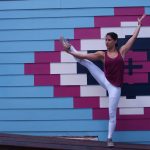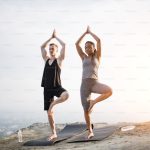A yogi’s feet work hard during any asana practice. They are our foundations in so many ways, but are you really clear what should be happening down there? Here’s a few tips to firm up yours or your students’ feet and fire up our foundations.
I always think that our feet are truly the unsung heroes of our body. They spend most of the time swaddled in socks and shoes; unseen, unloved and unnoticed until things go wrong. Despite this lack of attention they faithfully move us around — taking us thousands of steps every day.
Every time we come to the mat we expect them to be the very foundation of our practice, but how often do we pay attention to what they’re doing? Or take time explore the effect that our foot position can have on the entirety of a pose?
The Wonders of Feet
Our feet are amazing things — each foot is made up of 26 bones (28 if you include the sesamoid bones under the big toe). These bones make 33 joints that are held together by 107 ligaments and controlled by 19 muscles and tendons. The foot is wonderfully adaptable and when we are stood on a foot it is a mobile platform that is constantly adapting to the surface it is placed upon. As we prepare to take a step and lift our heel, it transforms into a powerful, rigid lever that propels us forwards into each stride. This metamorphosis happens thousands of times every day in each of our feet.
Our feet are also a major player in a process called proprioception. This is where sensors in our muscles (proprioceptors), tendons and joint capsules are constantly telling our brain what position our joints are in. The brain instantaneously processes that information and sends messages back to the muscles to fine tune their action. You can see proprioception at work in the flickering of muscles and tendons around the ankle on single leg balances as our body works to keep upright. You can generally tell an experienced yogi when there’s less wobbling and flickering in the foot muscles because their proprioception is honed to perfection.
Getting the Foundations Right
One of the most commonly heard instructions given in any yoga class is “ground through your feet” or a variation on that theme. What does this mean? Sometimes it helps to think of the foot as having four points where pressure should be greatest — often called the four corners of the foot. These are:
- The ball of the foot at the base of the big toe (the distal end of the medial arch)
- The ball of the foot at the base of the little toe (the distal end of the lateral arch)
- The inside edge of the heel (the proximal end of the medial arch)
- The outside edge of the heel (the proximal end of the lateral arch)
Some teachers describe these as the four wheels of a roller skate to help students feel the right locations.
The trick to grounding well is to push down on all four corners of the foot at the same time, which is so much harder than it sounds. For ages I just stood on my feet and hoped that was what the teacher meant by grounding — oh, how wrong I was!
How to Ground like a Pro!
- Stand in Tādāsana with feet hips width apart.
- Have little play and roll your feet in and out to identify the four corners of the feet in your mind’s eye then come back to the middle with your weight equally on both feet.
- Push the inner edge of the heel and inner end of the ball of the foot into the ground and feel how your legs medially rotate (turn inwards) so the whole inside of the leg becomes active.
- Keeping this medial pressure and inner leg activity, push down on the outer corners of the foot so that there is equal pressure on all four points.
- Drawing back the outer edges of the thighs at the same time as you ground through the outer corners activates the outer legs to balance the inner leg energy.
The result: feet grounded through all four corners and wonderfully active legs! When you have the hang of it in Mountain Pose, move on to Chair Pose and Padangusthasana and enjoy how each pose strengthens and stabilises you.
Further Grounding
The next challenge is to try asymmetrical poses (like Warrior 1, Warrior 2 or Extended Side Angle) while holding on to that same awareness. It’s much harder to ground through all four corners in the back leg of these poses and there is a tendency to overly emphasise either the inner or outer edges.
To get it right, ground through the inner corners first and activate the inner leg before working the outer thigh and pushing on the outer edges of the foot to balance the pressure on all four corners at the same time.
You can use the same sequence to ground your feet and strengthen your legs in down dog too. This really energises the legs and almost magically rises the sit bones as your heel sink towards the floor. It is a lovely feeling and well worth the effort!
The Bottom Line
It’s not easy to ground well through your feet. It will take practice, practice and more practice but be patient. One day you will feel the wonderful strength and stability that well grounded feet will bring to your practice. You will feel the space that this stability brings to and that is truly worth waiting for.












